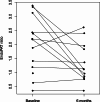Endothelial dysfunction in breast cancer survivors on aromatase inhibitors: changes over time
- PMID: 38693561
- PMCID: PMC11062002
- DOI: 10.1186/s40959-024-00227-z
Endothelial dysfunction in breast cancer survivors on aromatase inhibitors: changes over time
Abstract
Background: Breast cancer is estimated to comprise about 290,560 new cases in 2022. Aromatase inhibitors (AIs) are recommended as adjuvant treatment for estrogen-receptor positive (ER+) breast carcinoma in postmenopausal women, which includes approximately two-thirds of all women with breast cancer. AIs inhibit the peripheral conversion of androgens to estrogen by deactivation of the aromatase enzyme, leading to a reduction in serum estrogen level in postmenopausal women with ER+ breast carcinoma. Estrogen is known for its cardiovascular (CV) protective properties through a variety of mechanisms including vasodilation of blood vessels and inhibition of vascular injury resulting in the prevention of atherosclerosis. In clinical trials and prospective cohorts, the long-term use of AIs can increase the risk for hypertension and hyperlipidemia. Studies demonstrate mixed results as to the impact of AIs on actual CV events and overall survival.
Methods: A single arm longitudinal study of 14 postmenopausal women with ER+ breast cancer prescribed adjuvant AIs at the University of Minnesota (UMN). Subjects with a history of known tobacco use, hypertension, hyperlipidemia, and diabetes were excluded to eliminate potential confounding factors. Participants underwent routine labs, blood pressure assessments, and vascular testing at baseline (prior to starting AIs) and at six months. Vascular assessment was performed using the EndoPAT 2000 and HDI/PulseWave CR-2000 Cardiovascular Profiling System and pulse contour analysis on two occasions as previously described. Vascular measurements were conducted by one trained vascular technician. Assessments were performed in triplicate, and the mean indices were used for analyses. All subjects were on an AI at the follow-up visit. The protocol was approved by the UMN Institutional Review Board and all participants were provided written informed consent. Baseline and follow-up characteristics were compared using Wilcoxon signed-rank tests. Analyses were performed using R version 3.6.1 (R Foundation for Statistical Computing, Vienna, Austria).
Results: After six months of AI treatment, EndoPAT® ratio declined to a median 1.12 (Q1: 0.85, Q3: 1.86; p = 0.045; Figure 1) and median estradiol levels decreased to 2 pg/mL (Q1: 2, Q3: 3; p=0.052). There was no evidence of association between change in EndoPAT® and change in estradiol level (p = 0.91). There were no statistically significant changes in small or large arterial elasticity.
Conclusions: We hypothesize that long-term use of AI can lead to persistent endothelial dysfunction, and further investigation is necessary. In our study, patients were on AI for approximately 5-10 years. As a result, we do not have data on whether these changes, such as EndoPAT® ratio and the elasticity of small and large arterial, are reversible with discontinuation of AI. These findings set the stage for a larger study to more conclusively determine the association between AI exposure and cardiovascular outcomes. Further studies should evaluate for multivariate associations withmodifiable risk factors for CV disease.
Keywords: Aromatase inhibitors; Breast cancer; Cardiotoxicity; Endothelial function.
© 2024. The Author(s).
Conflict of interest statement
The authors declare no competing interests.
Figures
Update of
-
Endothelial Dysfunction in Breast Cancer Survivors on Aromatase Inhibitors: Changes over Time.Res Sq [Preprint]. 2023 Apr 3:rs.3.rs-2758909. doi: 10.21203/rs.3.rs-2758909/v1. Res Sq. 2023. Update in: Cardiooncology. 2024 May 1;10(1):27. doi: 10.1186/s40959-024-00227-z. PMID: 37066265 Free PMC article. Updated. Preprint.
Similar articles
-
Endothelial Dysfunction in Breast Cancer Survivors on Aromatase Inhibitors: Changes over Time.Res Sq [Preprint]. 2023 Apr 3:rs.3.rs-2758909. doi: 10.21203/rs.3.rs-2758909/v1. Res Sq. 2023. Update in: Cardiooncology. 2024 May 1;10(1):27. doi: 10.1186/s40959-024-00227-z. PMID: 37066265 Free PMC article. Updated. Preprint.
-
Vascular function in breast cancer survivors on aromatase inhibitors: a pilot study.Breast Cancer Res Treat. 2017 Nov;166(2):541-547. doi: 10.1007/s10549-017-4447-6. Epub 2017 Aug 11. Breast Cancer Res Treat. 2017. PMID: 28801846 Free PMC article.
-
The role of aromatase inhibitors in early breast cancer.Curr Treat Options Oncol. 2003 Apr;4(2):133-40. doi: 10.1007/s11864-003-0014-y. Curr Treat Options Oncol. 2003. PMID: 12594939 Review.
-
Attenuated peripheral endothelial function among women treated with aromatase inhibitors for breast cancer.Coron Artery Dis. 2018 Dec;29(8):687-693. doi: 10.1097/MCA.0000000000000666. Coron Artery Dis. 2018. PMID: 30379695
-
Exercise therapies for preventing or treating aromatase inhibitor-induced musculoskeletal symptoms in early breast cancer.Cochrane Database Syst Rev. 2020 Jan 29;1(1):CD012988. doi: 10.1002/14651858.CD012988.pub2. Cochrane Database Syst Rev. 2020. PMID: 31994181 Free PMC article.
Cited by
-
Immuno-inflammatory mechanisms in cardio-oncology: new hopes for immunotargeted therapies.Front Oncol. 2025 Mar 13;15:1516977. doi: 10.3389/fonc.2025.1516977. eCollection 2025. Front Oncol. 2025. PMID: 40182041 Free PMC article. Review.
References
-
- Miller KD, Nogueira L, Mariotto AB et al. Cancer treatment and survivorship statistics, 2019. CA Cancer J Clin. 2019. - PubMed
Grants and funding
LinkOut - more resources
Full Text Sources
Research Materials

